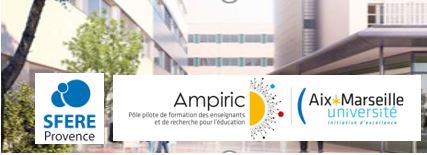Le contexte de cette étude est le projet « e-Pim » (Incubateur de pédagogie immersive pour la réalité virtuelle) dans un collège pilote. Ce projet est une Recherche Action Participative -RAP- (McIntyre, 2008) avec une approche interdisciplinaire, autour de l'utilisation d'un Monde Virtuel comme technologie de médiation pour des activités éducative. Nous nous focalisons ici sur le rôle du corps du chercheur à travers l'exploration des dimensions intervenant dans la dynamique de sa corporéité (Mathey-Pierre & Bourdoncle, 1995).
L'état de l'art sur la RAP disant peu de chose sur ce point, nous cherchons à comprendre comment le corps du chercheur est négocié dans une RAP impliquant à la fois des espaces physiques et virtuels. Dans cette méthodologie, les chercheurs sont impliqués « sur le terrain », dans des réunions avec les enseignants, les élèves et les administratifs, et dans le Monde Virtuel comme observateur et participants selon le type d'action. Le chercheur se retrouve dans un espace « autre », celui de la classe ou de l'école, où son statut est souvent renégocié. Le corps est en effet le cadre de référence dans lequel se déroulent toutes nos expériences, et devient, à travers les sens, les sensations et les réalisations, le lien principal entre l'esprit et le monde (Cheville, 2006). Le concept de corporéité a gagné du terrain ces dernières années, en particulier à la lumière des nouvelles formes d'interaction et d'engagement avec les technologies émergentes (Green, Brock et Kaufman, 2004).
La méthodologie de la RAP est décrite pour mieux comprendre le rôle du chercheur et la diversité des données qualitatives et longitudinales, utilisées ici dans un objectif d'analyse secondaire : photos de réunion, vidéo en classe et inworld, e-mails. La variété de ces données permet une exploitation des traces de négociation du chercheur avec son corps dans un espace social, à la fois physique et virtuel.
Les corps physiques et sociaux sont constitués et reconstitués via des interactions corporelles avec le monde matériel selon trois dimensions spatiales: a) en classe et dans le collège b) en ligne dans le monde virtuel et c) dans l'espace hybride (en classe et dans le monde virtuel avec un avatar). Nous explicitons enfin des nouvelles routines professionnelles mises en œuvre par les chercheurs à travers ces négociations récurrentes et cumulatives de leur corporéité dans la RAP.
Nous concluons que la méthodologie PAR gagnerait à mieux mettre en évidence cette négociation des modes de présence et d'acceptation du corps des chercheurs.
MOTS-CLÉS
Recherche Action Participative ; corps du chercheur ; Monde Virtuel ; éducation
ABSTRACT
The context of this study is the “e-Pim” project (Incubator of Immersive Pedagogy for Virtual Reality) in a pilot secondary school. The project is a Participatory Action Research -PAR- (McIntyre, 2008) with an interdisciplinary approach, on the uses of a Virtual World as a mediating technology for educational activities.
We focus specifically on the role of the researcher's body through a study of the dimensions of embodiment when acting in a PAR (Mathey-Pierre and Bourdoncle, 1995). Because little is said about this point in the literature, our research question is the following: how is the body of the researcher negotiated in a PAR involving both physical and virtual spaces?
In the PAR, the researchers are involved “on the ground”, in meetings with the teachers, pupils and administrators, and in the Virtual World as either observer or participant according to the nature of the action. Thus, the researchers find themselves in “other” spaces, that of the classroom or the school, where their status is often renegotiated. The body is indeed the frame of reference in which all our experiences take place; and becomes, through senses, sensations and performances, the main link between the mind and the world (Cheville, 2006). The concept of embodiment has gained currency in recent years, particularly in light of new forms of interaction and engagement with emergent technology (Green, Brock and Kaufman, 2004).
We describe the methodology we used to understand the role of the researcher, and the diversity of the qualitative and longitudinal data used here in a secondary analysis purpose: photos of meetings, inclass and inworld videos, e-mails. The variety of these data allow us to analyse traces of the researcher's negotiation of his body in an evolving social space which is also a physical and virtual space.
In our research context, physical and social bodies are constituted and reconstituted via corporeal interactions with the material world, according to three spatial dimensions : a) in the classroom and in the meeting spaces; b) in the online space of the Virtual World and c) in the hybrid space (classroom presence modes as combined with presence in the Virtual World). We then explicit new professional routines enacted by the researchers through the recurrent and cumulative negotiations of their embodiment in the PAR.
We conclude that PAR methodology would gain at better highlighting this negotiation of the modes of presence and acceptance of the body of the researchers.
KEYWORDS
Participatory Action Research; resarcher's body; Virtual World; education.
REFERENCES
Cheville, J. (2006). The bias of materiality in sociocultural research: Reconceiving embodiment. Mind, Culture, and Activity, 13, 25–37.
Green, M. C., Brock, T. C., & Kaufman, G. F. (2004). Understanding media enjoyment: The role of transportation into narrative worlds. Communication Theory, 14(4), 311-327.
Mathey-Pierre, C. & Bourdoncle, R. (1995). Autour du mot « professionnalité ». Recherche & formation, 19(1), 137-148.
McIntyre, A. (2008). Participatory Action research. Qualitative Research methods series, 52, Sage University Paper, Sage, Los Angeles.

 PDF version
PDF version
